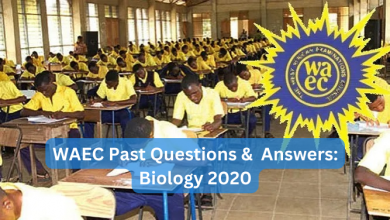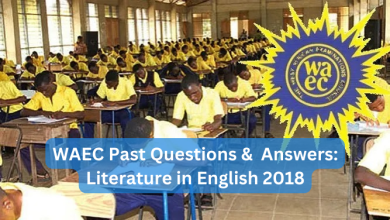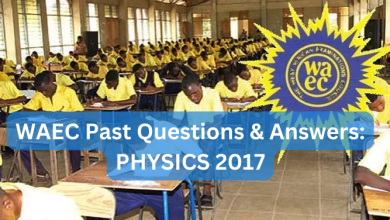WAEC Past Questions & Answer: CHEMISTRY 2020

Welcome to our WAEC past question and answer series. In this post, we will be sharing Chemistry 2020 past questions and their answers for various subjects. Stay tuned enjoy while learning.
1. Which of the following substances is an example of a fine chemical?
A. Sodium hydroxide
B. Hydrochloric acid
C. Ethylene
D. Ammonia
2
The IUPAC name of the compound represented by the structure below is ?
A. 2- chloro but-I ,3-diene.
B. But-1,3-chlorodiene.
C. 2-chloro but-diene.
D. 3 -chloro but -1.3-diene.
3. Which or the following substances is a polypeptide?
A. Starch
B. Glycogen
C. Protein
D. Fats
4. Which or the following products could be formed during incomplete combustion of a hydrocarbon.
i.Carbon ii. Hydrogen III. Carbon (Il) oxide
A. I only
B. I and II only
C. I and III only
D. II and III only
5. What quantity of electrons is lost when one mole of iron (II) ions is oxidised to iron (III) ?
A. 0 mole
B. 3 moles
C. I mole
D. 2 moles
6. What is the mass of silver deposited when 24,125 C of electricity is passed through a solution or silver salt.
[Ag = 108, IF = 96,500 C ]
A. 432g
B. 108g
C. 54g
D. 27g
7. Equal masses of calcium trioxocarbonate(iv) were added to dilute hydrochloric acid at the temperature specified. Under which of the following conditions would the reaction be slowest?
A. Calcium trioxocarbonate ( iv ) chips a 20°C
B. CalcIum trioxocarbonate (IV) chips at 40°C
C. Calcium trioxocarbonate (IV) powder at 20’C
D. Calcium trioxocarbonate (IV) powder at 40’C
8. The high solubility of ethanol in water is due to?
A. its low boiling point.
B. its low freezing point.
C. its covalent nature
D. hydrogen bonding
9. Which of the following pairs of properties of alkali metals decreases down the group?
A. First ionisation energy and reactivity
B. melting point and atomic radius
C. Reactivity and electronegativity
D. First ionisation energy and melting point
10. The most suitable process of obtaining water from an aqueous solution of sugar i
A. Crystallisation
B. Distillation
C. Filtration
D. Decantation
11. Group VIl elements in their combined states are called?
A. Halogens
B. Anions
C. Halide
D. Cations
12. When an ionic bond is broken, bonding electrons are
A. shared between participating atoms
B. gained by the most electropositive atom
C. gained by the most electronegative atom
D. lost by both participating atoms.
13. The oxidation state of chlorine in NaClO3 is?
A. +1
B. +3
C. +5
D. +6
14. A balanced chemical equation is based on the law of?
A. Periodicity
B. Constant composition
C. Multiple proportion
D. Conservation of mass
15. Which of the following pairs of elements has the greatest difference in electronegativity?
A. Na and F
B. Na and CI
C. Na and Br
D. Na and I
16. A factor that is considered most important when siting a chemical industry is?
A. nearness to other industrial establishments
B. nearness to raw materials
C. favourable climate conditions
D. availability of storage facilities
17. The boiling point of pentane is higher than that of propane because?
A. carbon-carbon single bonds are stronger than carbon-hydrogen bonds.
B. Pentane has more covalent bonds to break
C. Pentane does not burn easily as propane
D. The intermolecular forces in pentane are stronger than those of propane
18. Which of the following solids would not decompose on heating?
A. Ammonium chloride
B. Lead (i) trioxonitrate (V)
C. Potassium trioxocarbonate (IV)
D. Sodium hydrogen trioxocarbonate (IV)
19. The following molecules have double covalent bonds between two atoms except?
A. oxygen
B. carbon (IV)oxide
C. ethene
D. water
20. The type of isomerism exhibited by cis and trans isomers is?
A. positional
B. geometrical
C. functional
D. optical
21. Which of the following compounds has the lowest boiling point?
A. C4H10
B. CH3COOH
C. H2O
D. C2H5OH
22. An alkanol containing 60% carbon by mass would have a molecular formula [H=1.0. C-12.0, O= 16.0]
A. CH3OH
B. C2H5OH
C. C3H7OH
D. C4H9OH
23. Which of the following compounds would release hydrogen when reacted with sodium metal?
I. CH3COOH
II. CH3CH2OH
III. CH3COOCH3
A. I only
B. I and II only
C. Il and IIl only
D. I and Ill only
24. Which of the following substances is not a reducing agent?
A. C
B. CO
C. O2
D. H2
25. Which of the following statements is correct for a reaction at equilibrium?
A. All reactions cease to occur
B. The reaction has gone to completion
C. The rates of the forward and backward reactions are equal
D. The amount of product equals the amount of reactants
26. Which of the following reactions are always exothermic?
1. Neutralisation Il. Decomposition III. Combustion
A. I and II only
B. I and III only
C. II and IIl only
D. I, II and III
27. Which of the following standard conditions is not correct about energy changes?
A. Standard temperature is 298K
B. B. Standard pressure is 1 atm
C. Concentration of solution must be 1 mol/dm3
D. ΔH at 298 K is the activation energy
28. f 5.0 cm−3 of 0.200 mol dm(^-3\) Na2CO3 was diluted to 250cm(^-3\) solution, what would be the concentration of the resulting solution?
A. 0.004 mol dm(^-3\)
B. 0.020 mol dm(^-3\)
C. 0.200 mol dm(^-3\)
D. 0.400 mol dm(^-3\)
29. The initial volume and pressure of a given mass of gas is V and 3.P. What is its pressure if its volume is increased to 2V at constant temperature?
A. 3 P
B. 2P
C. frac32 P
D. frac23 P
30. What volume of oxygen at s.t.p is required to burn completely 7.5 dm3 of methane according to the following equation?
CH4 g + 202 g → CO2 g + H2Og
A. 3.75 dm3
B. 7.59 dm3
C. 15.0 dm3
D. 30.0dm3
31. When 250 cm3 of a saturated solution of CuSO4 at 30°C was evaporated to dryness, 5.0 g of the salt was obtained..
What is the solubility of the salt at 30°C? [CuSO4 = 160]
A. 0.031
B. 0.125
C. 0.640
D. 1.560
32. The bond between NH3 and H+ in NH4+ is?
A. dative
B. covalent
C. hydrogen
D. electrovalent
33. Which of the following oxides has a giant covalent structure?
A. Al2O3
B. Na2O
C. P4O10
D. SiO2
34. Which of the following hydroxides is not readily soluble in water?
A. NH4OH
B. Ca(OH)2
C. NaOH
D. KOH
35. Which of the following statements about the solubility of a salt is correct?
A. A salt whose solubility increases with temperature would not crystallise easily on cooling
B. A salt whose solubility is independent of temperature would normally crystallise out on cooling
C. Crystallisation would be efficient in separating out a salt whose solubility increases considerably with temperature
D. Solubility of a solid does not affect its crystallisation
36. How many moles of H2SO4 are there in 50 cm3 of 0.108 mol dm3 solution of the acid?
A. 5.4x 10
B. 5.4 x 10−3
C. 5.4 x 10−2
D. 5.4x 10−1
37. If 20 cm3 of sodium hydroxide was neutralised by 20 cm3 of 0.01 mol dm3 tetraoxosulphate(VI) acid, what is the concentration of the solution?
A. 0.010
B. 0.020
C. 0.100
D. 0.150
38. “Electrons always occupy the lowest empty energy level” is a statement of
A. Aufbau Principle
B. Hund’s rule
C. Pauli Exclusion Principle
D. Periodic law
39. Which of the following metals does not react with water to produce hydrogen?
A. Copper
B. Potassium
C. Sodium
D. Zinc
40. Which of the following arrangement of elements is in decreasing order of electronegativity?
A. Na, Mg, Al, Si, P
B. Na, A1, Mg, P, Si
C. P, Mg, Na, Si, Al
D. P, Si, Al, Mg, Na
41. The metallic bond in magnesium is stronger than that in calcium because magnesium has a
A. larger atomic size.
B. smaller atomic size
C. greater number of valence electrons
D. lower melting point
42. Consider the reaction represented by the following equation:
AgNO3 + NaCl → AgCl + NaNO3.
The steps that could be taken to obtain pure dry sample of AgCI (s) from the mixture includes
A. heating to saturation and drying
B. filtering and evaporation to dryness
C. filtering, washing and drying
D. crystallising and allowing to cool
43. many electrons does 3115P3− contain?
A. 12
B. 15
C. 16
D. 18
44. The atomic number of an atom would be equal to its mass number if it
A. has a totally filled valence shell
B. has a high charge to mass ratio
C. does not contain neutrons
D. exhibits isotopy
45. Which of the following processes is not exhibited by atoms in order to attain more stable electron configuration?
A. Gaining of electrons
B. Hybridisation of orbitals
C. Losing electrons
D. Sharing electron
46. Which of the following quantities is a molar quantity?
A. Molarity
B. Molar mass
C. Mass concentration
D. Molality
47. Dilution factor is the?
A. amount of distilled water that is added to the concentrated solution to dilute it
B. Quantity of distilled water added to l dm3 of the concentrated solution to give the dilute solution
C. number of times the volume of the concentrated solution is diluted to give the dilute solution
D. act of diluting the concentrated solution to obtain the dilute solution
48. Calcium chloride is an ionic compound. Which of the following statements account for its ionic character?
I. Calcium has high ionisation energy. II. Calcium has low ionisation energy. III. Chlorine has high electron affinity. IV. Chlorine has high Ionisation energy.
A. I and Il only
B. I, II and IV only
C. II, IIl and IV only
D. I, II, III and IV
49. An example of a biodegradable pollutant is?
A. plastic
B. sewage
C. carbon (II) oxide
D. hydrogen sulphide
50. Which or the following products could be formed during incomplete combustion of a hydrocarbon.
i.Carbon ii. Hydrogen III. Carbon (Il) oxide
A. I only
B. I and II only
C. I and III only
D. II and III only
Answers To Questions
- B
- A
- C
- C
- B
- D
- A
- D
- D
- A
- C
- B
- C
- D
- A
- B
- B
- C
- D
- B
- A
- C
- B
- B
- C
- B
- D
- A
- C
- C
- B
- A
- D
- B
- C
- B
- B
- A
- A
- D
- B
- C
- D
- C
- B
- C
- C
- C
- B
- C





